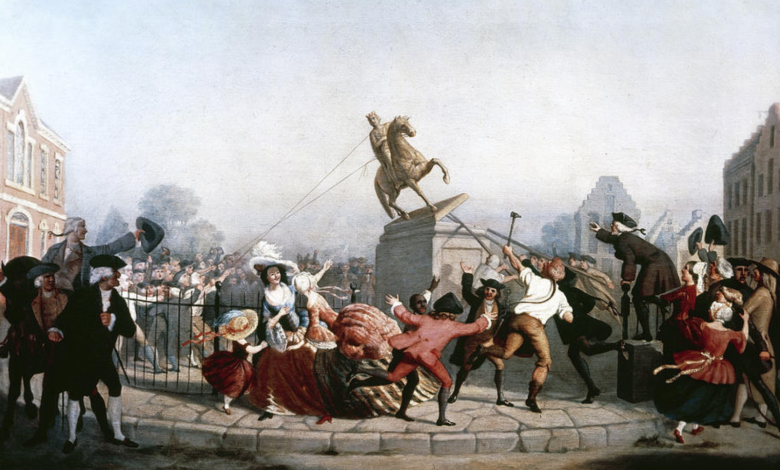Is It a Crime to Tear Down Statues?

All across the nation, Confederate statues are being forcibly taken down by protestors. Statues memorializing known slave owners, members of the Confederacy, and others known for their white supremacy and human rights violations are being defaced – beheaded, spray painted, hanged, and burned. Some of the statues to have been toppled already include people like Ulysses S. Grant, Christopher Columbus, George Washington, and Francis Scott Key. While there has been quite a lot of debate on whether this is a just end to racist statues or removing history, the question remains: Is it legal to tear down statues?
Why Are They Tearing Down Statues?
All this follows the police killings of George Floyd, Breonna Taylor, Rayshard Brooks, Andres Guardado, and others, all within a manner of a couple of months. The Black Lives Matter (BLM) Movement has taken to the streets every day since, demanding the defunding of police across the nation.
In the case of the statue of Christopher Columbus at the Minnesota State Capital, activists had been trying to get them to take it down for a while. But, according to Mike Forcia of AIM of Twin Cities, which is an advocacy group for Native Americans and the organizers of the rally, “It’s always ‘you got to wait; there’s a process you got to go through.”’ For Forcia and many others, “the time for being complacent is over.”
In some cases, the forced removal of the statues has been enough to convince cities to take down other offensive statues. But there are still many petitions being passed around to get others removed and others being torn down every day. Many are suggesting that they be replaced with statues of Black leaders, inventors, politicians, and other greats.
It’s also worth noting that tearing down statues is not a new method of protesting. In fact, after reading the Declaration of Independence to Washington’s troops, New Yorkers and soldiers tore down a statue of the tyrannical George III. The fall of the Berlin Wall could, in a way, be considered tearing down something symbolically in the same way, as well as the many statues and memorials to Hitler, Stalin, and the such being removed after their defeats.
While those who fight to leave these monuments as they are argue that their purpose is “for all generations to learn not only from our heroes and our greatest achievements, but to also ensure that we learn from our mistakes and our darkest hours,” according to Alabama’s Governor Ivey, protestors today have a different idea. An article in The Yale Law Journal explains that, “Destroying art or cultural property provides the individual or group carrying out the destruction the opportunity to violently repudiate the message or content of the property in question.” It is also seen as a way to provide an amplified voice to those that are not always heard by elected officials and those who have the authority to make these changes.
Is Tearing Down Statues a Crime?

Federal Level
Federal guidance for this largely began in 1966 with the National Historic Protection Act, inspired by a fear that urban development was leading to the destruction of valuable pieces of cultural significance. It states that, “the preservation of this irreplaceable heritage is in the public interest so that its vital legacy of cultural, educational, aesthetic, inspirational, economic, and energy benefits will be maintained and enriched for future generations of Americans.” While this doesn’t provide any laws deeming the destruction of statues illegal, it does establish what is considered a protected historic object. Although, what it did establish is pretty vague. As it was simply introduced to protect historic monuments and its descriptions of cultural property, it doesn’t have much of a guideline to determining what should and shouldn’t be preserved.
As far as actual federal laws go, there are two that address the destruction of this cultural property, but they are for more specific memorials. 16 U.S. Code §?426i makes it a crime to:
“willfully destroy, mutilate, deface, injure, or remove any monument, column, statue, memorial structure, or work of art that shall be erected or placed upon the grounds of the battlefield by lawful authority, or shall willfully destroy or remove any fence, railing, inclosure, or other work for the protection or ornament of said battlefield, or any portion thereof; or shall willfully destroy, cut, hack, bark, break down, or otherwise injure any tree, bush, or shrubbery that may be growing upon said battlefield, or shall cut down or fell or remove any timber, battle relic, tree, or trees growing or being upon such battlefield, except by permission of the Secretary of the Interior, or shall willfully remove or destroy any breastworks, earthworks, walls, or other defenses or shelter, or any part thereof, constructed by the armies formerly engaged in the battle on the lands or approaches to the battlefield.”
In other words, it’s pretty much illegal to purposefully cause any type of destruction to any piece of property on a battlefield. Violating this law can result in a misdemeanor with a fine of at least $5 to $100.
Then, there’s 18 U.S. Code §?1369, which protects veterans’ memorials from destruction. It applies to anyone who “willfully injures or destroys, or attempts to injure or destroy, any structure, plaque, statue, or other monument on public property commemorating the service of any person or persons in the armed forces of the United States,” but it becomes federal jurisdiction only if, when committing the offense, the defendant either travels or uses the mail or some other form of interstate commerce. This charge can come with up to ten years in prison and a fine.

State Level
There are several states that have their own laws specifically regarding the removal of statues and other types of monuments. Most of them are southern states, and some of them were implemented recently in response to the removal of statues. It’s likely that violating most of the laws would result in a misdemeanor or felony charge, depending on the severity of the offense. However, as it is a state matter, the charges are usually elevated.
North Carolina
Adopted in 2015, North Carolina has General Statute § 100-2.1, which states that, “a monument, memorial, or work of art owned by the State may not be removed, relocated, or altered in any way without the approval of the North Carolina Historical Commission.” It does allow for the object to be relocated for up to 90 days after the completion of a project and other extreme circumstances; however, it must still be put somewhere of the same prominence but not a museum or cemetery (unless that’s where it was originally located).
South Carolina
The South Carolina Heritage Act gives protection to statues in that state. This law protects some Confederate memorial objects in particular. It specifically addresses several Confederate flags and “prohibits the removal, changing, or renaming of any local or state monument, marker, memorial, school, or street erected or named in honor of the Confederacy or the civil rights movement.” Exceptions can be made only with a joint resolution after the approval of two-thirds of both Legislatures. Through this legislation, in 2015, South Carolina removed the Confederate flag on the Statehouse grounds. Recently, there has been a lot of push back on this Act, however, and activists are fighting to have it repealed.
Tennessee
Tennessee actually put an Act into effect rather recently. The Tennessee Heritage Protection Act of 2016 states that, “no memorial regarding a
historic conflict, historic entity, historic event, historic figure, or historic
organization that is, or is located on, public property, may be removed, renamed, relocated, altered, rededicated, or otherwise disturbed or altered.” They have a specific system for challenging this Act in order to make any alterations to any of these memorials, also requiring a majority two-thirds vote but from the Tennessee Historical Commission. In 2018, a Tennessee Republican representative sought to make it a Class E felony to violate this act in any way, but it died in the House.
Georgia
Georgia’s Code § 50-3-1 rules: “No publicly owned monument or memorial erected, constructed, created, or maintained on the public property of this state or its agencies, departments, authorities, or instrumentalities in honor of the military service of any past or present military personnel of this state, the United States of America or the several states thereof, or the Confederate States of America or the several states thereof shall be relocated, removed, concealed, obscured, or altered in any fashion; provided, however, that appropriate measures for the preservation, protection, and interpretation of such monuments or memorials shall not be prohibited.” In 2019, Georgia amended this code in order to include a penalty of up to three times the cost of the damage that the defendant caused, legal fees, and expenses for the repair or replacement of the damaged property.
Alabama
In 2017, Alabama put into effect the Alabama Memorial Preservation Act, which works “to prohibit the relocation, removal, alteration, renaming, or other disturbance of monuments located on public property which have been in place for 20 or more years,” as well as create the Committee on Alabama Monument Protection. The process, like most of these other laws, is long and detailed, requiring several written statements. Violating this act can result in a $25,000 fine for each violation. In fact, just last week, the city of Mobile was fined this $25,000 for removing the statue of Admiral Raphael Semmes, which will be put in a museum where it can receive historical context.
Mississippi
Mississippi’s monument protection is far reaching, including all objects or structures memorializing the following:
- Revolutionary War
- War of 1812
- Mexican-American War
- War Between the States
- Spanish-American War
- World War I
- World War II
- Korean War
- Vietnam War
- Persian Gulf War
- War in Iraq
- Native American Wars
The only exception is when the monument is obstructing the use, construction, or maintenance of public transportation facilities, as long as it’s on the Mississippi Transportation Commission property. It also allows for items to be moved to “a more suitable location if it is determined that the location is more appropriate to displaying the monument.” While it doesn’t have any penalties listed, it does allow for the law to become involved in the prevention of any of this defacement or alteration.
Virginia
Virginia has a monument law that is also explicit about exactly which war monuments are and aren’t covered through the following list of conflicts:
- Algonquin War
- French and Indian War
- Revolutionary War
- War of 1812
- Mexican-American War
- Confederate or Union monuments or memorials of the War Between the States
- Spanish-American War
- World War I
- World War II
- Korean War
- Vietnam War
- Operation Desert Shield-Desert Storm
- Global War on Terrorism
- Operation Enduring Freedom
- Operation Iraqi Freedom
Any monuments, structures, and objects related to these are protected from being removed, damaged, or defaced. It also prohibits the placement of Union monuments on Confederate memorials or Confederate monuments on Union memorials. The funding of the erection of additional memorials to these conflicts is discussed, and it can raise money or set aside funds specifically for these projects.
However, Virginia has had an update to this law that alters it drastically. Beginning July 1, 2020, Virginia may take down, move, or contextualize Confederate war memorials through Senate Bill 183 and House Bill 1537. Co-sponsor of the bill Sally Hudson recognized the victory, stating that “Communities across the Commonwealth will finally have the freedom to reckon with our public history and decide for ourselves what to celebrate.”

Cases of Statues Being Removed
While the penalties and charges differ across states, there are still plenty of cases throughout the states to get an idea of what is typically considered illegal and what charges tend to come with the crimes.
Durham Confederate Statue
In 2017, following the white nationalist protests in Charlottesville, Virginia to prevent the removal of a statue of Robert E. Lee, Durham, North Carolina protestors threw a rope around a Confederate statue and pulled it down. The North Carolina Central University student responsible for climbing up and fastening the rope was charged with participation in a riot with property damage exceeding $1,500, inciting others to riot, and disorderly conduct by injury to a statue. They arrested and charged seven others with misdemeanors in defacing a public building or monument, conspiracy to deface a public building or monument, and injury to real property. However, mostly because prosecutors couldn’t definitively prove that the protestors were at the scene and participated in the removal of the statue, all charged were dropped against the protestors.
Birmingham Confederate Monument
Birmingham’s mayor in 2017, Mayor William Bell, along with the city’s council, came to the decision that a 50 foot obelisk – a Confederate monument – was inappropriate and a danger to the city. However, as Alabama’s Memorial Preservation Act prevents just that, Mayor Bell instead built a barrier around the monument to just hide it. The Attorney General found that to also be a violation of the Act and sued Birmingham. The state won the lawsuit, and Birmingham had to pay the $25,000 fine.
Then, earlier this month, the Attorney General filed a lawsuit against Birmingham again for the removal of another Confederate monument. The current mayor, Mayor Randall Woodfin, believes that the price of civil unrest that would result from leaving the monument was more than the civil fine they would have to pay.
Miami Christopher Columbus Statue
More recently, on June 10, 2020, seven protestors were arrested for vandalizing a statue of Christopher Columbus in Miami, Florida. The vandalism consisted of spray paint on the statue, with a sickle and hammer, “George Floyd,” “BLM,” and various other phrases. However, police say that only three of the protestors were arrested just for the vandalism. They all face various charges, ranging from unlawful assembly to disorderly conduct, incite to riot, criminal mischief, and resisting an officer.

A Tumultuous History and Discussion for the Future
As the protests continue to go on with no end in sight, it’s almost certain that more statues will be coming down. As of now, there have not been many arrests made specifically for defacing statues during these BLM protests. However, there have been cases of vigilantism, with individuals entering the protests and sometimes becoming violent to protect monuments from being torn down.
As far as whether tearing down statues is a crime or not, it really depends on your state, especially if your state has a protective measure in place specifically for the protection of the monument. However, if you do deface, tear down, or otherwise damage a protected monument, you may be subject to charges even if you don’t live in one of these states, as it’s likely a cause for vandalism charges. There has been recent discussion all over the country on whether these statues should remain up, and there may be grounds for legal removal in some states.



